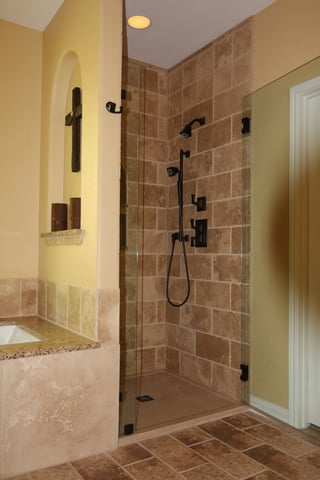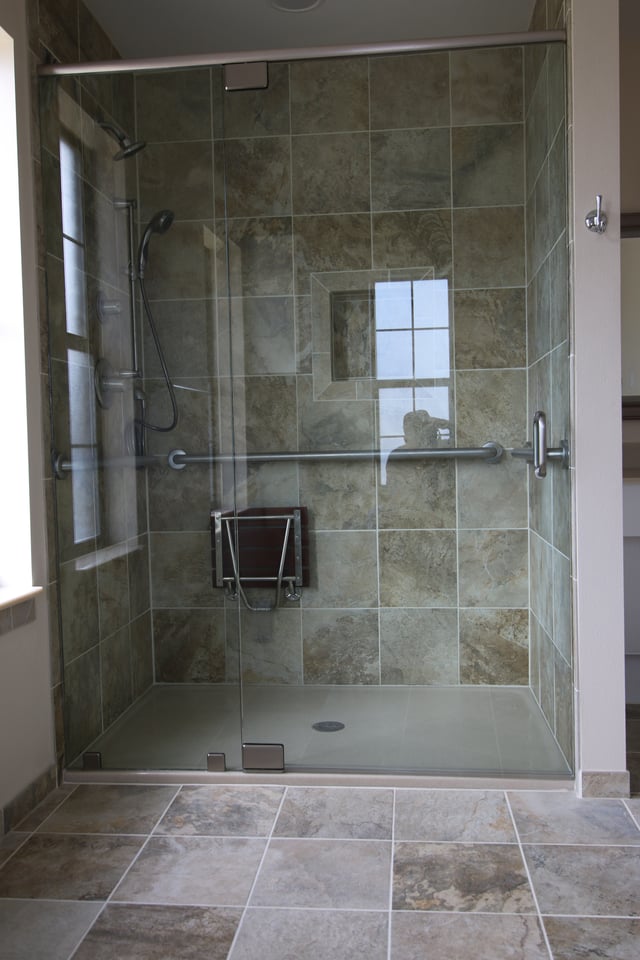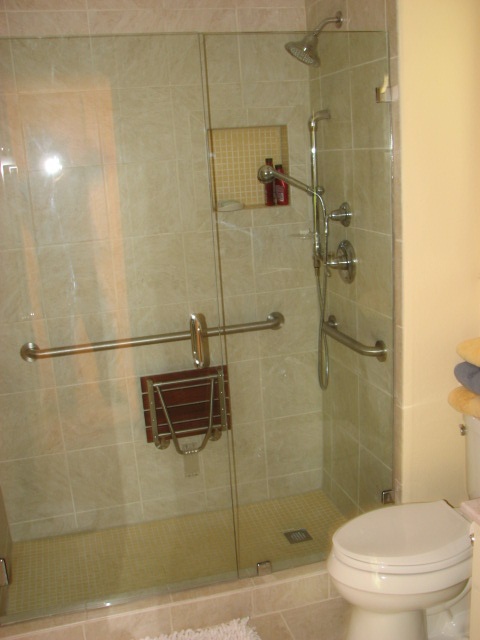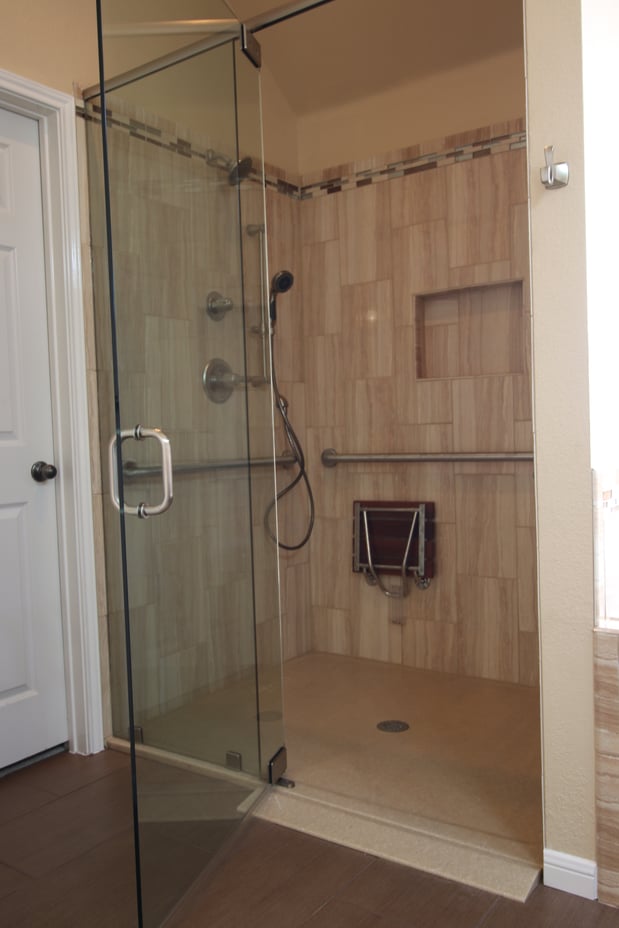Incorporating universal design principles into your home can facilitate aging-in-place goals, while comfortably addressing the diverse needs of all ages and mobility levels using your home. There are seven criteria which must be met to be considered a universal design no matter which area of the home you are referring to. Any design for an Austin bathroom remodel must be equally useful to everyone, have flexibility in it's usefulness, be simple and intuitive, be perceived by everyone, have a tolerance for error, require little physical effort, and it must maintain an adequate area for approach and use. Any complexity or discriminating attribute to a design will doom it in terms of being considered universal in nature.

Universal Design (UD) does not equate to accessibility design even though they both are concerned with ergonomics and human function issues. The ADA guidelines for accessibility were created as a means to help those people with extreme disabilities within our society who are a narrow and specific cross section of the masses. A UD approach broadly takes into account moderate impairments or disabilities, temporary health conditions, and the varying abilities of anyone within a home regardless of their age or size. In other words, an ADA accessible home would be designed for the one person with the disability whereas a UD home is designed for everyone. Features like single-story design, bedrooms and bathrooms on the ground floor, day lighting through larger windows and skylights, and wider doors and hallways appeal to users of all ages. With baby boomers eyeing a future where they'll age in place and younger people renovating older homes, the Harvard Joint Center for Housing Studies is anticipating healthy growth for the U.S. home improvement market through 2025.
However, if you're considering aging-in-place upgrades, making improvements in the bathroom can deliver the greatest return on your investment. Upgrades to improve a bathroom's usability and safety can help people remain in their homes longer. Universal design home improvements can benefit all ages within your home. Making these upgrades at a younger age can prepare your home to meet your needs in your golden years, while allowing you to enjoy the comforts early on. Designing for specific physical conditions will lessen the impact of say arthritis, restricted mobility, or loss of vision by using combinations of products, concepts, and techniques available today. Working as a team, a trained CAPS specialist along with any family caretakers or therapists is able to identify the day to day problems weighing on those with health limitations. If you are considering an aging in place remodel for your home don't just contact any local remodeler in your area and expect a satisfactory accessible home modification.
The bathroom has the reputation of being the most dangerous room within your home because of water usage. Any improvements helping to prevent a future accident or creating a space which makes it easier to use all the facilities within the room are obviously a plus for any homeowner. Modifications to accommodate chair height toilets, pedestal sinks, easy to use faucets, walk in tubs, non-skid flooring, and custom walk in shower seating can be of great use to any homeowner.
Young Austin homeowners are always looking for ways to bring their existing older home's bathrooms up to date. Bathroom remodels for these smaller baths can incorporate a number of the items listed above in moderation to fit any budget. Using beautiful ceramic tiles in an interesting design, updating plumbing fixtures, and the use of neutral colors can create a small bathroom with a "wow" factor. It is quite possible to produce a small but charmingly remodled bath on a budget. A project that is affordable plus the fact that it will add resale value to your home cannot be denied. Check out all the options before committing to a plan and then stick to it. Consider the ease of use for anyone within the bath. Plan for the future. Always hire a local and professional builder. Remember that producing change orders because no one thought of "that" can be expensive. Create the style for your Austin bathroom remodel that best gives you a feeling of pride!
If you are fortunate in having a larger space to deal with there will be increased costs due to the larger area to finish -as in more tiles for a bigger area and the labor to install them. Your costs may go down per square foot but you are certainly dealing with more coverage and increased costs. You need to consider that plumbers, electricians, tile setters, framers, drywall workers, carpenters, and insulation installers, just to name a few trades, will be involved in your bathroom remodel. Now how about the demolition that will be involved before the actual construction begins? Sometimes the preparations behind the scenes take longer than building the new bathroom remodel itself. Perhaps there isn't enough water volume to supply your chosen bathroom fixtures requiring a pipe to be upgraded or there just isn't sufficient fall for a gravity drain to work naturally that necessitates a lift pump system be installed. What are the new electrical requirements and layout and do these require dedicated or GFI circuits and will the existing electrical panel handle the new circuit breakers?
Considering a new walk in shower design? You can design the space so it doesn't require a door for splash protection or you can take the route of a clean looking frameless glass shower enclosure. This will surely set you back at least $900. Maintain a wider door opening. The end result will be a sophisticated clean look of beauty enclosing your new shower. Whether the door sits upon a curb or you have a specific need for a curbless situation you will be satisfied with your choice. The curbless choice means you're thinking ahead for a hopefully temporary physical need. Installing wood blocking within the shower walls can facilitate installing future grab bars or a folding seat. Are the shower controls and heads accessible to everyone?
Let's face it, an accessible home is needed by all of us at some time in our lives. This is true whether it's for ourselves, a family member, or a guest. The need is certainly not driven by age but is a result of life's experience. Any family living with a disability among any of the generations within it's group can always benefit from additional accessibility. This will in turn increase safety and independence for all involved as they go through life.
Aging in place home modifications are available through T-Square Company in Austin. Each universal design/build situation will be customized to fit your personal needs. Call 512-444-0097 today to begin to prepare for the accessible second chapter of your life while remaining safe and secure in your existing home.
CAPS 1636580

















